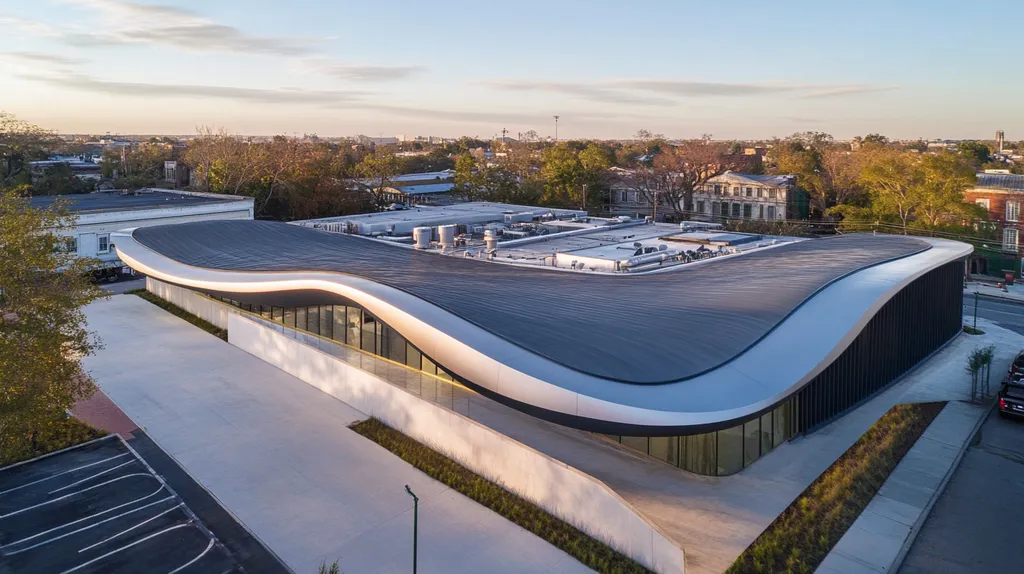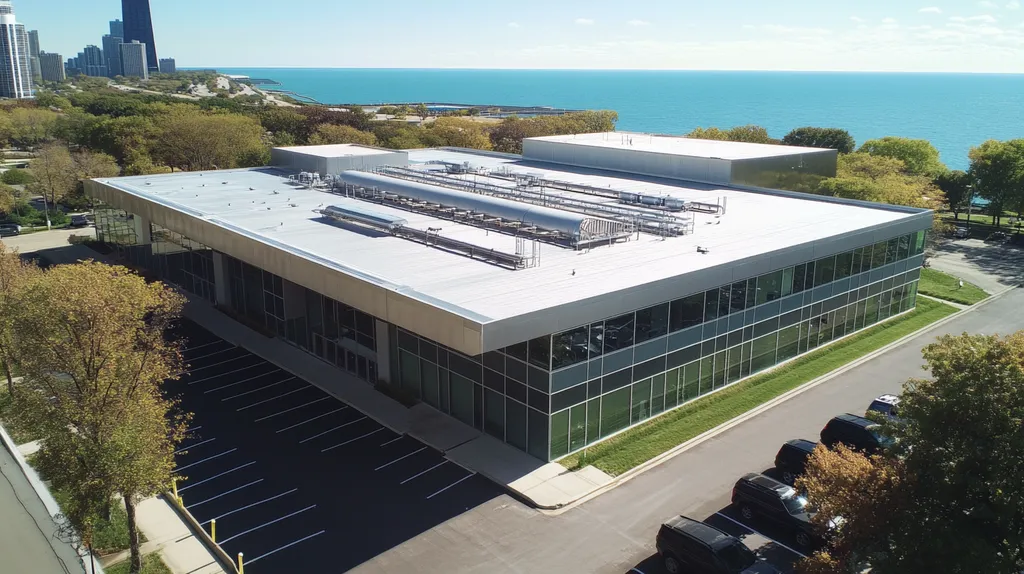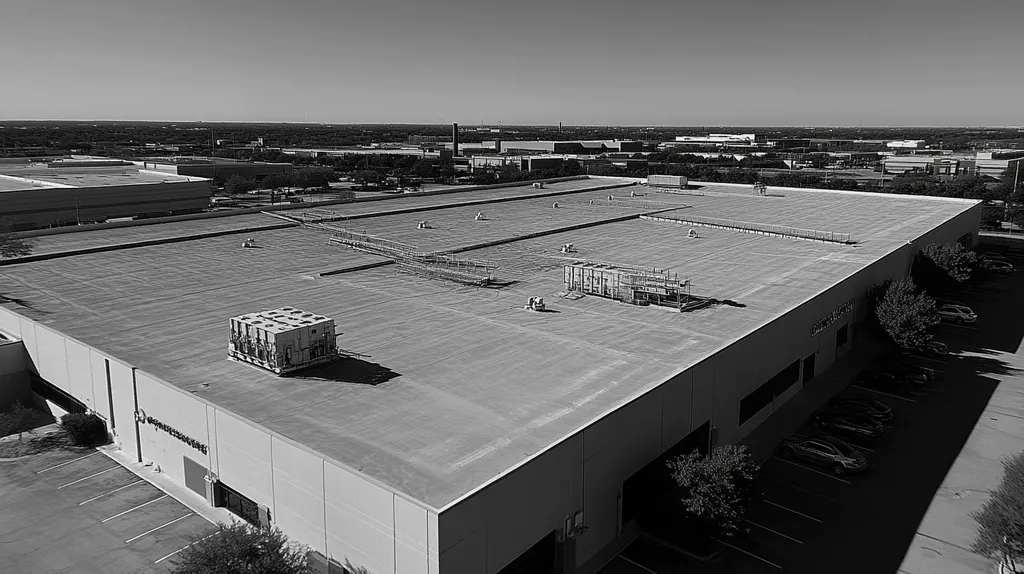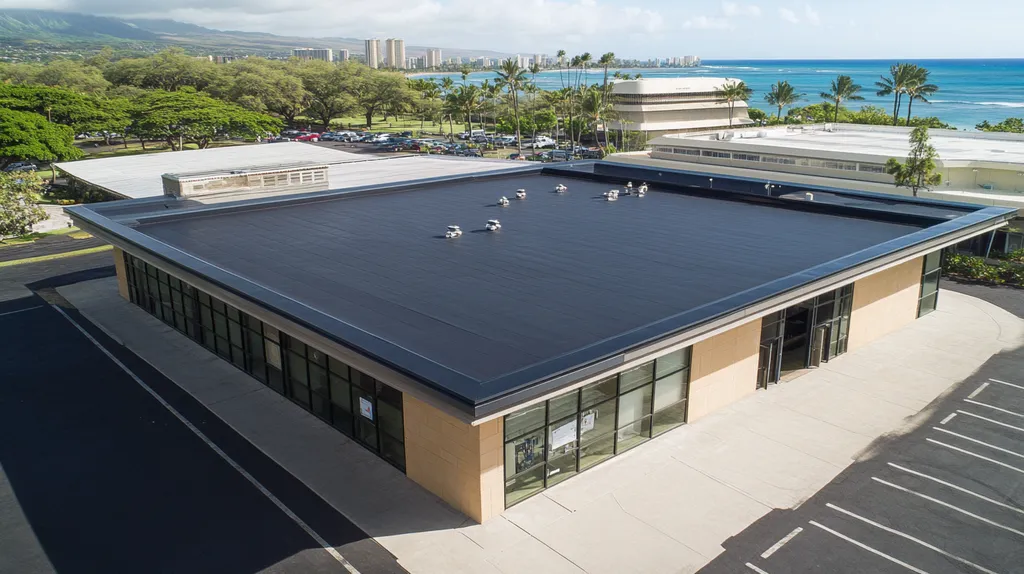In today’s commercial roofing landscape, where a single miscalculation can lead to hundreds of thousands in unexpected costs, mastering technology-driven cost analysis isn’t just smart—it’s essential for survival.
With material prices climbing 20% year over year and labor shortages affecting 89% of roofing projects, property owners need cutting-edge tools to navigate budget planning.
From artificial intelligence that predicts maintenance needs to software that analyzes lifecycle costs, modern technology is revolutionizing how we approach roofing investments.
This guide unpacks the essential tools and techniques that savvy property owners use to make informed financial decisions about their commercial roofs.
SECTION 1: THE BASICS EXPLAINED
Decoding the financial nuances of roofing decisions isn’t just smart; it’s essential for commercial property owners. With material prices soaring and labor becoming increasingly scarce, having a precise grasp on roofing budgets is crucial to avoid unpleasant surprises. Poor budgeting can lead to unexpected repairs or even the need for an early roof replacement, which can strain an organization’s finances. This section unpacks technology in cost analysis, discusses its importance, and explains how it operates within the roofing industry.
What It Is (In Plain Language)
Technology in cost analysis involves digital tools and software that assist in estimating, predicting, and managing roofing expenses. These range from straightforward calculators to sophisticated software that weave together multiple data points. They offer detailed insights into material costs, labor rates, and even long-term maintenance needs.
With these technologies, property owners can make better financial forecasts. Traditional methods often lean on outdated guesstimates or broad rules. In contrast, cost analysis technology delivers precise calculations customized to individual roofing projects.
These tools can also tap into historical data from past projects, enriching future decisions. This approach not only sharpens cost predictions but also helps spotlight patterns and potential savings.
In short, technology in cost analysis serves as a vital foundation for informed decision-making in the commercial roofing world.
Why It Matters (To Your Building)
Accurate cost analysis in roofing does more than streamline budgeting—it’s vital for the overall efficiency and financial health of commercial properties. Neglecting roofing cost considerations can lead to prolonged downtime or hefty repair bills.
By investing in advanced cost analysis tools, property owners can simplify their decision-making process. Automated systems can quickly generate reports that compare the best roofing materials and their lifecycle costs, enabling owners to select the most cost-effective solutions.
Moreover, buildings with well-maintained roofs tend to enjoy increased energy efficiency and reduced utility bills. Proper budgeting enables funds to be set aside for regular maintenance, which is crucial for prolonging the roof’s lifespan.
Ultimately, grasping and utilizing technology in cost analysis is key to preserving the long-term structural integrity of buildings.
How It Works
Cost analysis technology functions by gathering and analyzing vast amounts of data related to roofing projects. This data encompasses material prices, labor costs, and past performance metrics. Advanced systems leverage algorithms to sift through this information, producing accurate forecasts.
Some tools even offer real-time updates as material costs shift or new technologies arise—an invaluable feature in today’s unpredictable market where timely information can lead to significant cost savings.
Users can access these tools through cloud-based platforms, fostering collaboration with contractors and engineers. Quick decisions can be made based on the latest cost data, minimizing project delays.
Additionally, many of these technologies facilitate scenario analysis, empowering property owners to evaluate multiple options before locking in their budgets. This function aids in understanding the financial impacts of various roofing choices over time.
In essence, the mechanism of cost analysis technology merges thorough data analysis with user-friendly interfaces to drive smarter roofing investment decisions.
SECTION 2: PRACTICAL APPLICATIONS
In a world where roofing costs can spike without warning, mastering technology in cost analysis is essential for property owners. For instance, a minor leak, if ignored, could balloon into a $20,000 repair. Utilizing tech-driven budgeting can save property owners from such financial disasters. This section dives into the everyday applications of cost analysis tools, highlights the critical moments when these tools are most beneficial, and examines how they interact with other building management systems for a holistic approach.
Common Uses & Examples
In the realm of commercial roofing, the applications of technology in cost analysis are vast. One major application is lifecycle cost analysis, where innovative software tools assess the total cost of ownership over the lifespan of a roof. Property managers can leverage these tools to weigh the long-term expenses of various materials and installation techniques.
Another notable application is Building Information Modeling (BIM). BIM enables precise estimates by creating three-dimensional models of roofs. This precision helps mitigate costly miscalculations that could otherwise derail budgets. For example, a facility manager can visualize roof details with BIM before construction ever kicks off.
Moreover, the rise of cloud-based platforms that monitor real-time roofing conditions is changing the game. These platforms empower managers to budget for proactive maintenance by issuing alerts about potential repairs before they escalate into major issues.
In essence, these technological tools not only make budgeting more accurate but also ensure that financial allocations reflect the true costs associated with effective roof management and maintenance.
When You Need It Most
Knowing when to harness technology for cost analysis is vital for successful roofing management. One crucial moment is during a roof replacement project, where early cost estimation can dramatically influence budget allocation and timelines. Relying on modern cost analysis tools ensures that all possible expenses are accounted for upfront, preventing mid-project financial headaches.
Annual budget planning is another critical juncture. Using historical data and predictive analytics allows facility managers to forecast maintenance needs and costs more accurately. For instance, if increased wear is spotted on a specific roofing type, the manager can proactively budget for either a replacement or more rigorous maintenance in the upcoming year.
Extreme weather events are also a key time to utilize this technology. Rapid assessments of damage can be facilitated, along with quick cost estimates for repairs, ensuring that roofs get restored efficiently. Timeliness in this context can mean the difference between a minor fix and a costly emergency repair.
Ultimately, the savvy integration of cost analysis technology not only mitigates risks, but also enhances financial planning across various roofing projects.
Interactions With Other Systems
The power of cost analysis technology in commercial roofing amplifies when integrated with other building management systems. One effective combination is roofing cost analysis paired with project management software. This collaboration guarantees that all team members access the same financial data, fostering transparency and informed decisions.
Additionally, connecting cost analysis tools with maintenance management systems creates a synergy that mitigates unexpected costs. For example, a management system can indicate when a roof is likely to deteriorate, enabling timely budgeting and repairs before any failure occurs.
Furthermore, integrating roofing cost analysis with energy management systems provides valuable insights into how roofing choices influence overall energy efficiency. By examining how roof insulation impacts heating and cooling costs, property owners can make decisions that positively affect both their budgets and the environment.
In summary, the intricate connections between roofing cost analysis tools and other systems culminate in a comprehensive approach to facility management, significantly boosting overall operational efficiency.
SECTION 3: KEY TERMINOLOGY DECODED
In the fast-paced world of commercial roofing, grasping key terminology isn’t just helpful—it’s vital for maintaining financial health. With the market poised for significant growth, property owners must master essential terms to make sound decisions. A single misstep due to misunderstood jargon can lead to financial headaches during budgeting. This section breaks down critical terms that profoundly impact roofing cost analysis, paving the way for clearer communication and better decision-making.
Essential Terms Explained
Every roofing system has its own set of terms that are integral to cost analysis. For example, “thermal insulation” refers to materials designed to reduce heat loss, influencing both initial installation costs and long-term energy expenses. Understanding “roof pitch” is equally important, as it affects not only aesthetic choices but also the materials and techniques used, with direct implications for pricing.
Another cornerstone term is “life cycle cost,” which encompasses all expenses over the roof’s lifespan—not just the upfront costs. By accounting for maintenance, potential energy savings, and eventual replacement, property owners can make more informed choices. Additionally, “load-bearing capacity” defines how much weight a roof can handle, influencing material selection and installation methods.
Property owners are encouraged to become familiar with these terms, ensuring they can clearly communicate with contractors and suppliers. Mastery of these concepts empowers stakeholders to analyze proposals effectively and understand the financial implications of different roofing options.
Industry Jargon Translated
The roofing industry is abundant with terminology that can be confusing for property owners. Take “R-value,” for instance; this metric measures insulation effectiveness and is crucial for energy efficiency. Facility managers should recognize that a higher R-value translates into lower energy bills over time.
Also worth noting is the term “deferred maintenance,” which highlights the risks associated with postponing essential repairs. Ignoring these necessary tasks can lead to escalating costs later. By thoroughly unpacking this terminology, property owners can better advocate for their needs and ensure they make informed roofing decisions.
Measurement & Units Simplified
Understanding the measurements and units involved in roofing is crucial for budget accuracy. Roofing areas are usually measured in square feet, while materials are sold by the square, which covers 100 square feet. Without clear communication, this can lead to pricing confusion that affects project budgeting.
In addition, “mil” is a common unit of measurement for membrane thickness, where 1 mil equals one-thousandth of an inch. This specification is vital for determining durability and can have a substantial impact on roofing costs. Misinterpreting these units can lead to overselling or underselling of materials.
Finally, temperature and weather conditions greatly influence roofing material performance but are often overlooked. Terms like “thermal expansion” explain how materials can change under varying temperatures, aiding property owners in selecting materials and planning budgets for future repairs.
SECTION 4: DECISION FACTORS
When it comes to commercial roofing, the stakes are high. With projects often costing tens of thousands of dollars, having a clear understanding of key decision factors is essential. Ignoring these elements can lead to financial pitfalls, such as choosing a product that results in higher maintenance costs or, worse yet, premature roof failure. This section dives into the critical cost considerations, performance trade-offs, and lifespan factors that guide property owners and facility managers toward smarter budgeting practices.
Cost Considerations
Cost is typically the foremost concern for property owners selecting a roofing solution. However, focusing solely on initial expenses can be misleading. A cheaper roofing material might save money upfront but could snowball into higher repair costs as time passes.
Additionally, the choice of roofing technology can greatly influence energy consumption. While energy-efficient materials may come with a steeper initial price tag, they often reduce utility bills in the long run, resulting in a solid return on investment. It’s also vital to consider warranties and insurance factors, which affect the overall cost picture.
Leveraging advanced technology in cost analysis enables better forecasting of future expenses. Tools can simulate various scenarios, allowing managers to effectively compare both short-term and long-term costs across different materials. This proactive approach leads to informed financial decisions.
Ultimately, understanding all components of cost helps ensure that roofing projects align with broader financial objectives and operational budgets. A detailed cost analysis highlights immediate expenses while also uncovering potential savings down the line.
Performance Trade-offs
The journey to selecting the right roofing material often involves making important performance trade-offs. Different roofing materials vary significantly in their ability to withstand weather conditions, their thermal insulation properties, and their overall lifespan. For instance, metal roofs may offer exceptional durability but typically have higher installation costs.
Choosing the right roofing solution should take the building’s unique needs and local climate into account. A roof that can endure extreme weather might require a more considerable initial investment but will provide vital protection and longevity—especially in regions prone to heavy snow or hail.
Advanced technology tools can deliver crucial performance metrics based on various conditions. By comparing performance ratings of available roofing options, facility managers can make decisions that maximize value and efficiency over time.
Neglecting to weigh these performance trade-offs can lead to choices that compromise building integrity and inflate energy costs. Thorough analysis ensures that selected materials deliver optimal benefits without draining resources.
Lifespan & Durability Factors
Lifespan and durability must be front and center in roofing discussions, as they factor directly into long-term costs and maintenance needs. The lifespan of a roof can vary significantly based on the materials used and the quality of installation. For example, high-quality single-ply membranes can last up to 30 years with proper care, while inferior options may need replacement in under a decade.
Furthermore, a roof’s ability to withstand environmental stressors like UV rays, moisture, and temperature fluctuations is essential. Property owners should assess if a roofing system’s lifespan aligns with their overall budget and investment goals. While longer-lasting roofs might require a larger initial outlay, they often result in substantial savings through reduced repairs and replacements over time.
Emerging technologies in design and materials science are also enhancing roof longevity and durability. Some innovative products now feature self-healing capabilities, extending their life and minimizing maintenance expenses.
In summary, grasping lifespan and durability helps facility managers and property owners make informed decisions that support long-term investment strategies, ensuring the safety and efficiency of their buildings. Accurate forecasting, bolstered by modern technology, offers the insights necessary for enduring roofing solutions.
SECTION 5: COMMON CHALLENGES
Even with top-notch technology in cost analysis, property owners and facilities managers still grapple with significant challenges in commercial roofing. Surprising maintenance costs, ever-changing material prices, and budget miscalculations are common pitfalls. Shockingly, nearly 60% of commercial properties suffer roofing failures due to a lack of proactive management. Recognizing these challenges is essential for making informed choices and minimizing risks.
Frequent Problems & Solutions
Unanticipated issues such as unexpected leaks, inadequate insulation, and poor material choices can wreak havoc on a roof’s lifespan. These challenges often translate into costly repairs and decreased asset value. For example, while vinyl roofing may seem like an economical pick initially, it can lead to higher out-of-pocket expenses down the line due to frequent maintenance needs.
To tackle these common problems, regular inspections and data analytics software play a crucial role. Utilizing tools like thermal imaging can catch leaks before they snowball into expensive repairs. Implementing a proactive maintenance strategy not only resolves current issues but also helps prevent future complications.
Investing in quality materials is essential for fewer headaches. For instance, high-performance membranes can significantly lower operational costs over time. A data-driven approach can guide property managers in selecting the best materials that will stand the test of time.
Collaborating with roofing professionals who are well-versed in advanced technologies can streamline decision-making. These experts can assist with budget forecasting and material selection, ultimately saving both time and money.
Warning Signs To Watch For
Identifying early warning signs can save considerable resources for property owners. For instance, water stains on ceilings or walls are red flags indicating potential roofing issues. Ignoring these visual cues can lead to severe water damage, resulting in costly repairs and disruptions to business operations.
Visible cracks or blisters on the roof surface can also indicate deeper troubles. Regular visual inspections, along with drone-assisted evaluations, can reveal these issues before they escalate into larger problems.
Another significant warning sign is the presence of excessive granules in downspouts, suggesting shingle deterioration. Such indicators should spur immediate professional assessments to avoid larger financial implications later on.
Equipping property managers with the right technology to identify and monitor these issues is essential. Automated monitoring systems can send alerts regarding changes in roof conditions, enabling timely interventions.
Preventative Approaches
Embracing preventative maintenance is essential for effective roofing management. Implementing a regular maintenance schedule can dramatically reduce unexpected costs and prolong the life of commercial roofs. For example, routinely cleaning gutters can thwart water buildup that leads to leaks.
Another smart strategy involves adopting roofing management software, which helps track maintenance schedules and associated costs. This technology offers valuable insights for better budget forecasting grounded in historical data.
Incorporating energy-efficient roofing solutions can also be a win-win for property owners. Reflective membranes not only cut down energy consumption but also extend roof longevity by minimizing thermal wear.
Educating facility managers about the importance of proactive strategies and investing in technology can pave the way for astute decision-making. A well-informed team is more likely to adopt successful preventative measures, ultimately translating into long-term cost savings.
SECTION 6: NEXT STEPS & RESOURCES
The importance of effective roofing budgets cannot be overstated. With stakes this high, property owners and facility managers need to tread carefully through the financial landscape of roofing. Inaccurate cost projections pose serious risks, from unexpected expenses to compromised project timelines and building integrity. Identifying best practices in seeking roofing solutions ensures that informed decisions lead to healthier budgets. This section presents essential questions to pose to providers, industry standards to keep in mind, and valuable resources for further learning.
Questions to Ask Providers
Engaging with roofing providers means diving deep with the right questions to ensure transparency. Start by asking about their experience with a range of roofing technologies and how they incorporate these tools into their cost analysis process. Understanding their pricing structure will illuminate factors that could influence future estimates.
Don’t hesitate to delve into the tools they use for cost analysis. Find out if they rely on automated platforms that simplify cost tracking and deliver real-time updates. Also, be on the lookout for any hidden fees or extra charges lurking in contracts—these can derail your budget if not addressed.
It’s equally vital to discuss warranties and post-installation support. Knowing the expected lifespan of materials and possible long-term savings can significantly shape overall budgeting. Clear communication is key to fully grasping the total investment required.
Industry Standards & Guidelines
Staying tuned in to industry standards and guidelines is crucial for accuracy in cost analysis. Organizations like the National Roofing Contractors Association (NRCA) provide invaluable resources and benchmarks for evaluating roofing systems. Familiarity with these standards can empower property owners to make more informed decisions.
Check how potential roofing solutions stack up against guidelines related to sustainability, energy efficiency, and safety. Non-compliance with local building codes or environmental regulations can lead to costly fines and additional expenses.
An understanding of lifecycle costing further sharpens budget forecasting. This approach accounts for the roof’s total cost of ownership over its lifespan, not just initial installation expenses. Leveraging these standards can set the stage for effective long-term planning.
Further Learning Simplified
Expanding knowledge about roofing technologies and cost analysis tools is a smart move for property owners. Online courses and webinars offered by industry experts cover cutting-edge trends in commercial roofing and budgeting strategies. Attending these sessions can unlock insights that elevate decision-making processes.
Subscribing to industry publications and newsletters keeps professionals informed about new technologies and cost-saving strategies. Many resources, such as free eBooks and whitepapers, summarize pivotal advancements that can guide smarter choices.
Finally, networking with fellow facility managers and property owners through industry forums can create shared learning experiences. This collaborative knowledge is invaluable when evaluating providers and exploring various roofing solutions.
Looking Ahead
As material costs continue rising 20% annually and 89% of projects face labor shortages, technology-driven cost analysis has become the make-or-break factor in commercial roofing success.
Property owners who embrace these digital tools see an average 30% reduction in unexpected expenses and gain the ability to forecast maintenance needs up to five years in advance.
From AI-powered maintenance prediction to comprehensive lifecycle analysis software, these technologies are no longer optional – they’re essential survival tools in modern commercial roofing.
The future belongs to those who can harness data analytics, automated monitoring, and integrated management platforms to make smarter, more strategic roofing investments.
The choice is clear: adapt to technology-driven cost analysis or risk being left behind in an increasingly complex and competitive market.
FREQUENTLY ASKED QUESTIONS
Q. What is technology in cost analysis for commercial roofs?
A. Technology in cost analysis includes software and tools that help estimate and manage roofing expenses. These can range from simple calculators to advanced systems that integrate multiple data points. By utilizing these tools, property owners can create accurate financial forecasts tailored to their specific commercial roofing projects.
Q. How do I apply cost analysis tools for my industrial roof?
A. Cost analysis tools can be applied during major roofing events, like replacements or budget planning. These tools assist in determining long-term costs, ensuring you allocate funds effectively. Additionally, leveraging software that monitors real-time conditions can empower proactive maintenance, helping to avoid costly repairs before they arise.
Q. What key terminology should I know for commercial roofing?
A. Familiarize yourself with terms like “thermal insulation,” “life cycle cost,” and “load-bearing capacity.” These concepts directly impact cost analysis and decision-making for your roofing projects. Understanding these terms will help you communicate effectively with contractors and assess various proposals accurately.
Q. What decision factors impact budgeting for a commercial roof?
A. Key decision factors include initial material costs, long-term maintenance expenses, and performance ratings of roofing options. Different materials will react differently to environmental stressors, affecting their lifespan. Understanding these trade-offs helps ensure your budget aligns with operational goals and minimizes future costs.
Q. What common challenges do property owners face with roofing?
A. Property owners often encounter unanticipated maintenance costs, fluctuating material prices, and miscalculations in budgeting. These issues can lead to significant financial strain. Employing routine inspections and data analysis can help mitigate these risks and provide insights for better decision-making.
Q. What questions should I ask roofing providers for my commercial projects?
A. Inquire about their experience with various roofing technologies, cost analysis tools, and transparency in pricing structures. Ask about warranties, post-installation support, and any hidden fees. This knowledge will help you understand the total investment and ensure effective collaboration.
Q. What are the benefits of lifecycle costing for my industrial roof?
A. Lifecycle costing helps assess the total cost of ownership over the roof’s lifespan, including maintenance and repairs. By evaluating these long-term expenses, property owners can make informed selections based on sustainability, efficiency, and overall value, resulting in healthier budgets and resource allocation.











